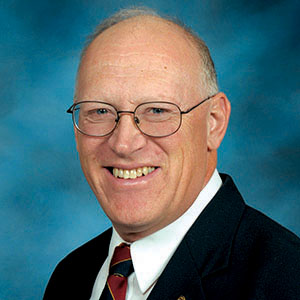Kansas Profile – Now That’s Rural: Chad Russell, fire chief
At a glance: Chad Russell volunteered at his local fire department and then chose to pursue firefighting as a career, working his way up to become fire chief in Andover. Through the years, he has seen the increased fire risk and higher water consumption caused by the spread of eastern red cedar trees in rural areas.
More information: Ron Wilson, rwilson@ksu.edu, 785-532-7690
Photos: Ron Wilson | Chad Russell
Website: Huck Boyd National Institute for Rural Development
May 29, 2024

By Ron Wilson, director of the Huck Boyd National Institute for Rural Development at Kansas State University
Forty times. That is the increased magnitude of water consumption attributed to an eastern red cedar tree, compared to open grasslands in Kansas. The unchecked spread of those cedar trees has not only consumed more water, it has created a fire hazard that can threaten homes, farms and families across the state.
Ironically, the strategic and well-managed use of fire can help remedy this same problem, according to a leading fire chief in rural Kansas
![]() Chad Russell is the fire chief in Andover. He is also a critical care paramedic. His department provides fire and rescue services for Andover and nearby Bruno township in Butler County.
Chad Russell is the fire chief in Andover. He is also a critical care paramedic. His department provides fire and rescue services for Andover and nearby Bruno township in Butler County.
At right: Chad Russell | Download this photo
Russell grew up in south central Kansas in Udall, a rural community of 661 people. That’s rural – but there’s more. His father was from Douglass, population 1,555, and his mother came from the rural township of Rock, population 94 people. Now, that’s rural.
Russell grew up working on his family’s farms. As a kid, he ran through the green tallgrass to get to his friend’s house, but the prairie today is not the same as he remembers it.
Russell volunteered at his local fire department and then decided to pursue firefighting as a career. He worked for the Cherryvale fire department and then the fire department in Kansas City, Kansas, where he met his wife.
“We wanted to raise our two daughters in a small town setting,” Russell said. They moved back to Cherryvale where he became fire chief.
His wife later went to Wichita State to become a certified physician’s assistant, and Russell became fire chief at Andover in 2014. “It’s a wonderful place to be,” Russell said.
Russell observed the challenges as urban growth moves into a rural setting.
“People move here from more populated areas and they may not be familiar with what it takes to take care of the land,” Russell said.
One thing he has observed is the growth of eastern red cedar forests. Such non-native cedars are considered an invasive species. They can quickly overgrow rangeland and consume much more than their share of water. Red cedars consume an estimated 40 times more water compared to native grassland. They can also become a fire hazard.
“I’m passionate about firefighter safety,” Russell said. “It becomes impossible to manage a fire when it’s in wall-to-wall cedars. As fire chief, I’ve gotten into some bad spots trying to get ahead of the fire in a cedar forest.”
Prescribed, managed burning is one natural way of controlling invasive cedars. When Russell asks new landowners why they have chosen not to burn, he is sometimes told, “I want the land to be just like it was in the 1850s.”
“The fact is, in the 1850s this land was tallgrass prairie,” Russell said. “Lightning and natural fires kept the trees out.”
In modern times, fast-spreading eastern red cedars have become a threat from both a water use and fire hazard standpoint.
In November 2023, Russell was elected president of the Kansas Association of Fire Chiefs. “I’m an environmentalist as much as an agriculture producer is,” he said. “Fire is a natural means to control invasive species and can be part of a healthy ecosystem. We would love to have people use fire wisely.”
“It’s best when neighbors get together and help each other burn, through organized burn associations or local grassroots efforts.”
His mother-in-law dreamed of going to Africa. In 2018, the whole family made the trip. “We made a photo safari onto the plains of Africa and it was breathtakingly beautiful,” Russell said. “It made me think of the Kansas Flint Hills, if we could control the cedar trees.”
“I want my grandkids to be able to enjoy these grasslands for future generations.”
Forty times. That’s the magnitude of increased water use by red cedars, compared to native rangeland. We commend Chad Russell of Andover for making a difference by championing firefighter safety and natural control of red cedars.
He is good at making this case many times.
Audio and text files of Kansas Profiles are available at http://www.kansasprofile.com. For more information about the Huck Boyd Institute, interested persons can visit http://www.huckboydinstitute.org.
***

K‑State Research and Extension is a short name for the Kansas State University Agricultural Experiment Station and Cooperative Extension Service, a program designed to generate and distribute useful knowledge for the well‑being of Kansans. Supported by county, state, federal and private funds, the program has county extension offices, experiment fields, area extension offices and regional research centers statewide. Its headquarters is on the K‑State campus in Manhattan. For more information, visit www.ksre.ksu.edu. K-State Research and Extension is an equal opportunity provider and employer.